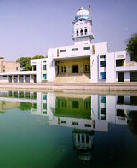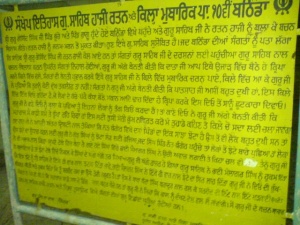Gurdwara Haji Rattan: Difference between revisions
No edit summary |
Allenwalla (talk | contribs) m (Getting late Lucky ji--what book? wow or vah, vah (PBUH)!/ Hadith collecters, wow. Going for a cluster of stars busy, busy.) |
||
| Line 1: | Line 1: | ||
[[Image:Hajiratan.jpg|thumb|right|300px]] | [[Image:Hajiratan.jpg|thumb|right|300px]] | ||
While on his way to Talwandi Sabo Guru Gobind Singh camped here for the night outside the mausoleum of the Muslim saint Haji Rattan. The tomb keepers tried to dissuade the Guru from sleeping here with the excuse that the place was haunted. Since the Guru | '''Haji Rattan''' is a most unusual name for a Sikh Gurdwara. While on his way to [[Talwandi Sabo]] [[Guru Gobind Singh]] camped here for the night outside the mausoleum of the Muslim saint Haji Rattan. The tomb's keepers tried to dissuade the Guru from sleeping here with the excuse that the place was haunted. Since Sikhs don't build tombs and the Guru like other Sikhs didn't believe in ghosts he spent the night here to show the people that such superstitions were ungrounded. | ||
One of the most intriguing things is that Haji Baba Ratan of Bhatinda in Punjab is claimed by Hindus, Muslims and Sikhs as their own despite his strong Muslim connections, pointed to most noteably by the addition to his name of Haji. Haji is only added to a Muslim's name after thay have attended and done all of the events associated with the Haj (the Pilgrimage to Mecca). | |||
According to one legend he was a Sabaha (companion, someone who actually had darshan of the Rasul not neccesarily a companion or friend as the word is usually defined) of the Muslim Prophet and is said to have lived for over 700 years. The first references to Haji Ratan in Islamic literature date back to the twelfth century. Several Hadith collectors traveled from as far as Andalusia and Central Asia to collect the supposed traditions pertaining to him. | |||
Abu Marwan Andalusi, a Spanish Muslim chronicler, visited Haji Ratan and penned an interesting sketch of him. He writes, "When he arrived at the Baba’s monastery, he was taken aback to see an ancient, wrinkled man, his cheeks covered with hair ‘as white as cotton’. The Baba addressed him in a language he could not understand, claiming, as was later translated for him, that he was present in Medina during the famed Battle of the Trench. He claimed at that time to be just fourteen years old. When the Prophet saw him laboring at the trenches, he blessed him with a long life." | |||
[[Image:Hajiratan1.jpg|thumb|right|300px]] | [[Image:Hajiratan1.jpg|thumb|right|300px]] | ||
[[Category:Gurudwaras in Bathinda District]] | [[Category:Gurudwaras in Bathinda District]] | ||
Revision as of 15:45, 11 July 2008
Haji Rattan is a most unusual name for a Sikh Gurdwara. While on his way to Talwandi Sabo Guru Gobind Singh camped here for the night outside the mausoleum of the Muslim saint Haji Rattan. The tomb's keepers tried to dissuade the Guru from sleeping here with the excuse that the place was haunted. Since Sikhs don't build tombs and the Guru like other Sikhs didn't believe in ghosts he spent the night here to show the people that such superstitions were ungrounded.
One of the most intriguing things is that Haji Baba Ratan of Bhatinda in Punjab is claimed by Hindus, Muslims and Sikhs as their own despite his strong Muslim connections, pointed to most noteably by the addition to his name of Haji. Haji is only added to a Muslim's name after thay have attended and done all of the events associated with the Haj (the Pilgrimage to Mecca).
According to one legend he was a Sabaha (companion, someone who actually had darshan of the Rasul not neccesarily a companion or friend as the word is usually defined) of the Muslim Prophet and is said to have lived for over 700 years. The first references to Haji Ratan in Islamic literature date back to the twelfth century. Several Hadith collectors traveled from as far as Andalusia and Central Asia to collect the supposed traditions pertaining to him.
Abu Marwan Andalusi, a Spanish Muslim chronicler, visited Haji Ratan and penned an interesting sketch of him. He writes, "When he arrived at the Baba’s monastery, he was taken aback to see an ancient, wrinkled man, his cheeks covered with hair ‘as white as cotton’. The Baba addressed him in a language he could not understand, claiming, as was later translated for him, that he was present in Medina during the famed Battle of the Trench. He claimed at that time to be just fourteen years old. When the Prophet saw him laboring at the trenches, he blessed him with a long life."


